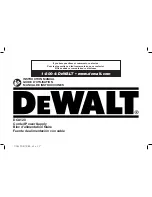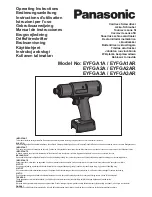
Operating the BLG-4000BC1 Model
1. Attach power tool cable to the BLG-4000 screwdriver and the transformer. Make sure notch at the cable
end aligns with the notch on the driver connector. Tighten knurled ground ring.
2. Plug in power cord to the back of the transformer and power outlet. Flip power switch to “ON” position
located on the front of transformer.
3. Select a bit. Retract the bit collar. Insert the bit and release the retracted collar. To avoid damaging
fasteners, make sure the proper bit is suitable for the head of the fastener.
4. The torque limit is determined by the tension of the coil spring housed in the torque adjustment nut. The
tighter the coil spring is wound the higher the torque limit is raised. See Torque Charts on page 9 to
determine the appropriate torque adjustment setting.
5. Rotate the torque adjustment nut to set the torque limit. Turn clockwise to increase torque and counter
clockwise to decrease torque. The scale adjacent to the Torque Adjustment Nut is a reference guide. The
torque output from the driver can change depending on various fastening factors like friction, type of joint,
and the type material being used like a washer. Verify torque setting with a torque testing system.
6. Turn driver on and check for proper rotation. FOR-clockwise, REV-counterclockwise.
7. To apply torque, squeeze the lever. The driver will automatically stop when the preset torque has been
reached.
8. To remove the screw, turn the FOR/REV switch to REV position.
BLG-BC1 Series Operating Instructions
Corporate Headquarters:
1080 North 11th Street, San Jose, CA 95112 Phone: (408) 292-2214 Fax: (408) 292-2733
www.mountztorque.com
Torque adjustment nut
Operating the BLG-5000BC1 Model
1. Attach power tool cable to the BLG-5000 screwdriver and the transformer. Make sure notch at the cable
end aligns with the notch on the driver connector. Tighten knurled ground ring.
2. Plug in power cord to the back of the transformer and power outlet. Flip power switch to “ON” position
located on the front of transformer.
3. Select a bit. Slide the bit collar forward. Insert the bit and release the collar. To avoid damaging fasteners,
make sure the proper bit is suitable for the head of the fastener.
4. The torque limit is determined by the tension of the coil spring housed in the tool. The tighter the coil spring
is wound the higher the torque limit is raised. See Torque Charts on page 9 to determine the appropriate
torque adjustment setting.
5. Using the “Hex Key wrench”, set the torque by referring to the torque adjustment scale “1 to 8”. Turn
clockwise to increase torque and counter clockwise to decrease torque. The torque adjustment scale
is a reference guide. The torque output from the driver can change depending on various fastening
factors like friction, type of joint, and the type material being used like a washer. Verify torque setting
with a torque testing system.
6. Turn driver on and check for proper rotation. FOR-clockwise, REV-counterclockwise.
7. To apply torque, squeeze the lever (If Push-to-Start setting is set-up for the BLG-5000* model - place
light downward pressure on the nose of the driver). The driver will automatically stop when the preset torque has been
reached.
8. To remove the screw, turn the FOR/REV switch to REV position.
* Note:
The BLG-5000 features a two-way start system (switchable between Lever
Start and Push-to-Start)
How to Change BLG-5000 to “Push” Start System
1. Unscrew the “switch lever shaft screw” and then take off the “switch lever”. Using
tweezers, move the selection SW near “P” (push) mark.
* Note:
Do not press or hit the SW or you may damage the SW or body case
.
Torque
adjustment
scale
Hex Key Wrench
Switch lever
shaft screw
Page 3
Switch lever
Slide switch
between L or P




























